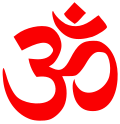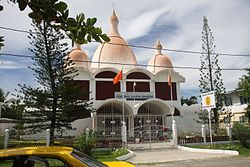 | |
| Total population | |
|---|---|
| 257,000 (2021) 31.0% of the population | |
| Regions with significant populations | |
| Religions | |
| Hinduism (Sanātana Dharma) Majority sect Sanātanī Minority sects Arya Samaj · Caribbean Shaktism (Kali Mai Dharam/Madrasi Hinduism) · Sathya Sai Baba movement ·Sieunarini (Sir Narain/Shiv Narayani) Panth · Hindu atheism ·others | |
| Scriptures | |
| Vedas · Puranas · Upanishads · Ramayana (incl. Ramcharitmanas version) · Mahabharata (incl. Bhagavad Gita ) · other Hindu texts | |
| Languages | |
| Sanskrit · Tamil ( liturgical languages ) English (Guyanese English Creole) · Guyanese Hindustani | |
| Related ethnic groups | |
| Trinidadian and Tobagonian Hindus · Surinamese Hindus · Jamaican Hindus · other Caribbean Hindus |
| Hinduism by country |
|---|
  |
| Full list |
Hinduism in Guyana is the religion of about 24.8% of the population in 2012. [1] This makes Guyana the country with the highest percentage of Hindu residents in the Western Hemisphere. [2]
